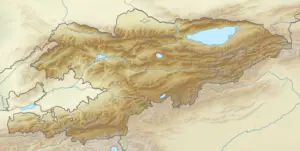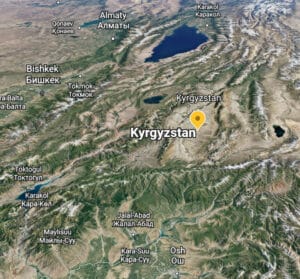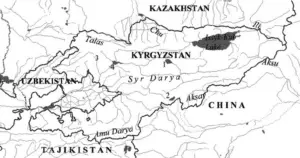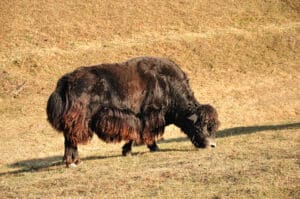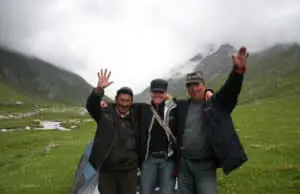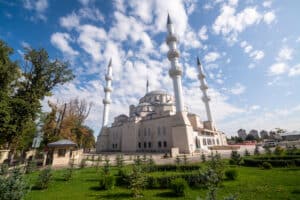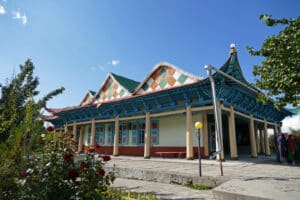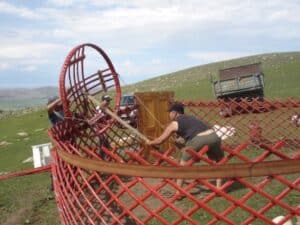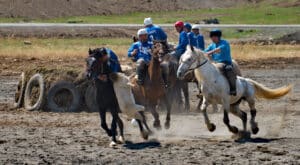Kyrgyzstan is a small, strikingly mountainous country near the center of the immense Eurasian landmass. Influences from diverse empires can be felt there today: Mongol, Turkic, Persian, Russian/Soviet, and Chinese. Its relative geographic inaccessibility means that the Kyrgyz have also been able to maintain practical independence from settled empires. Only Stalin’s forced collectivization in the 1930s and 1940s forced many Kyrgyz to give up their traditional nomadic lifestyle. It was not completely stamped out, however, and nomadic traditions remain central to Kyrgyz identity today.
GeoHistory and Historical Development
Kyrgyzstan’s geography has provided some protection from invasion, but has also hampered economic development. Kyrgyzstan is 93% mountainous and has no traditional agricultural heartland for the settled agriculture that traditionally supports the denser populations needed for economic specialization and development. The extreme mountains also mean that Kyrgyzstan has many rivers from the glacial runoff, but none are fully navigable and none are commercially viable. River transport, which is the most efficient and cost effective and usually requires no infrastructure investment, has played an important role in the early development of nearly all major economies, but is almost entirely absent in Kyrgyzstan.
- Relief map of Kyrgyzstan showing the country’s almost entirely mountainous territory.
- A screen grab from Google Earth showing the rippling East-West striations of Kyrgyzstan’s mountains.
- A map showing Kyrgyzstan’s major rivers. The country is well-watered, but none of the rivers are fully navigable or commercially viable transport routes. They are a source of fish for the population, however.
Kyrgyzstan is the most inland county in the world, some 1600 miles from ocean access. Thus, Kyrgyzstan has historically lacked the efficient access to international markets that has played a key role in the development of major economies by allowing sellers to sell their goods nearly anywhere. Even the development of roads and railroads is difficult due to the extremely mountainous terrain, meaning that for most of Kyrgyzstan’s history, its economy has remained local and ineffective transport using the backs of animals has been crucial to regional mobility.
Because of its geography, animals have been economically and culturally important to the Kyrgyz people – particularly horses, sheep, and yaks, which are used for transport and food. The need to raise these animals means that Kyrgyzstan is still strongly rooted in nomadic life and remains largely rural to this day.
Extreme mountains also tend to create pockets of population and thus the small country of Kyrgyzstan has many important regional differences and divisions. The legend of Manas holds that a great leader first united the 40 Kyrgyz tribes into one nation in the 10th century. Manas may or may not have been real, but his legend remains one of the most important foundational myths for modern Kyrgyzstan. This is because these tribal identities remain pronounced in Kyrgyzstan even today. The east-west striations of Kyrgyzstan’s mountains have also meant that its two major population centers: Bishkek in the north and Osh in the south, have developed separately and often see themselves as political rivals.
Although geography has provided some protective insularity for the Kyrgyz, it has not saved them from invasion. The Gok-Turks were, like the Krygyz, shamanistic and exceptional equestrians. They built an empire that absorbed the area of modern Kyrgyzstan from about 550-744. When the Gok-Turks fell, the Kyrgyz were quickly absorbed into the powerful Buddhist Uighur Empire where they remained nearly a century, a history that would have lasting effects on the development of northeast Kyrgyzstan. The Kyrgyz were then dominated by Muslim and increasingly Persianized peoples that would have a more lasting effect on the southwest. Later, the Mongols invaded and subjugated the Kyrgyz for nearly 200 years, ending only around 1510.
The east-west rows of sequential mountain chains allowed some routes of the Silk Road to pass through Kyrgyzstan. The route was rough and required that the animals be more lightly packed than usual, but proved economically viable. Unfortunately, this increased the risk of invasion as those empires attempted to control the trade routes. It also opened the area to peaceful cultural and economic exchange. The earliest accounts of the ancient Kyrgyz were written by the Chinese traveler Zhang Jian in the 2nd century BC, when he became the first to open a route from China to Persia through Kyrgyzstan. Economically valuable canvasaries eventually appeared in Kyrgyzstan, giving the Kyrgyz better access to the Silk Road to trade horses, musk, and furs (again, mostly animal-based products) for mirrors, weapons, horse equipment, jewelry, and more.
- Map of overland and maritime Silk Road routes used over the centuries.
- A detail map showing the Kyrgyz cities of Osh and Bishkek on the Silk Road routes. Note that they were on separate routes due to the mountains separating the two.
- The Tash-Rabat canvasary still survives in Kyrgyzstan. Photo from Stephen Lioy
All empires that ruled the Kyrygz absorbed them into their militaries and made use of their equestrian skills. In all cases, however, the Kyrgyz were able to maintain a large degree of freedom to maintain their language and traditional ways of life, as the geography helped make their complete subjugation almost impossible. This held true even under the Russian empire, which first conquered the area in the later 19th century.
Traditional life was first significantly disrupted under the intense efforts of the Soviets. However, not even the forced urbanization, industrialization, and collectivization was able to destroy the language and culture of the Kyrgyz.
Economy – Agriculture
Kyrgyzstan’s elevation and mountainous geographic barriers contribute to a dry climate with hot summers and very cold winters.
Slightly smaller than South Dakota, only 13% of Kyrgyzstan is suitable for intensive crop farming. This is dominated by potatoes, corn, sugar beets, wheat, and barley – all well suited to the climate and soil. Fruit, nuts, and vegetables are produced in economically significant amounts on smaller family plots and gardens.
Livestock production dominates Kyrgyz agriculture: sheep, cattle, and, increasingly, poultry. Horses are raised for transport, sport, and as a traditional source of meat and milk. Yak, an animal traditionally raised by the Kyrgyz, is also making a slow comeback.
While in 2014 agriculture employed about a third of the population, today it accounts for about 20% of full time employment (in the US, this number is 10%) due to greater efficiency as a result of focused government policy and international investment.
Economy – Minerals and Industry
Kyrgyzstan’s mountains hold significant amounts of gold, uranium, and mercury. The state’s largest economic actor is the Kumtor Gold Mine, which regularly accounts for over 10% of Kyrgyzstan’s GDP and is its single largest source of government revenue.
Although an economic lifeline, Kyrgyz mines are controversial relative to environmental impact and frequent calls for nationalization. Kumtor was finally taken under national management under new president Sadyr Japarov in 2021.
Other significant industries in Kyrgyzstan are connected to agriculture: textiles (esp. from local wool and leather) and food processing (esp. meat packing, dairy, and sugar). Electricity production, machinery, and other industries are also present.
Economy – Transport, Energy, and Potential Growth
Local hydropower production satisfies 90% of residential needs. Locally sourced coal is increasingly used in industry. Fuel for vehicles is imported from Russia and Kazakhstan.
Eco-tourism from Kyrygzstan’s breathtaking nature is often mentioned as a potential sources of economic growth. Using Kyrgyzstan’s many small fast-moving rivers to generate additional hydropower for domestic industry and export is another.
However, most economic sectors (including agriculture) are underdeveloped due to poor transport infrastructure. Local rivers are not commercially navigable. Roads and rails built under the USSR did not account for the borders of the republic. Today, routes often cross national borders, creating bottlenecks, additional tariff costs, and other problems. New transport routes are difficult to construct and maintain due to the mountainous terrain.
- The Toktogul Hydroelectric Power Station was constructed on the Naryn River in the 1970s. It has a capacity for 1,200 MW and helps regulate irrigation for surrounding farmland.
- Huge dump truck (bottom right) carrying the gold ore to the processing plant (left) at the massive Kumtor gold mine in Kyrgyzstan. Note the strip mining striations on the mountain.
- The yak is traditional to Kyrgyz herding. Although marginalized under the Soviets, yak herding is today making a comeback.
Society and Demographics
Of Kyrgyzstan’s 6.3 million citizens, only a third live in urban areas. About three quarters are ethnic Kyrgyz and 87% are Muslim. Most of the population is concentrated in regions around Bishkek, the capital, or along the Uzbek border that follows the rim of the fertile Ferghana Valley.
Islam first arrived in the 8th century, but only became dominant in the 19th. About 23% of Kyrgyz Muslims identify as Sunni, but most identify as “just Muslim.” Veils and beards are relatively rare; headscarves are increasingly common. Local Islamic practice incorporates elements from Tengrism, a shamanistic religion that predates Islam.
Uzbeks comprise about 15% of the population, concentrated mostly around the southern city of Osh. They have faced discrimination in an ethnic rivalry rooted in Ferghana Valley land disputes and further exacerbated by a rural/urban divide: the Kyrgyz are traditionally nomadic and the Uzbeks traditionally settled. This rivalry came to a head in the 2010 Osh race riots.
Most Russians left after the Soviet collapse but remain a shrinking 6% of the population. Russian Orthodoxy is the second most populous religion, at about 3-9%. The Russian language remains an official state language and is prevalent in urban areas, especially Bishkek, where it is at least as likely to be seen and heard as Kyrgyz. About 25% of Kyrgyz still receive at least part of their public education in Russian and the language is spoken as a second language by at least two million Kyrgyz who generally value the opportunity to work and do business in Russia and with Russians.
Dungans and Uighurs, Turkic peoples from what is now Western China, are the third and fourth largest minorities. Although less than 1% of the population, they have an outsized influence on local culture and cuisine.
Kyrgyzstan’s median age is just 26.3 years. Countries with very low median ages have great economic potential, with large workforces, but are also often facing pressure from growing populations and are more likely to see revolutions happen.
Briefly on Politics
Kyrgyzstan is a presidential, unicameral republic. It is a unitary state with three levels of local governance. Local entities are theoretically independent, but receive their funding from the center. Unfunded mandates from the center.
Its relative political pluralism and frequent changes of government earned it a title of “Central Asia’s only democracy,” but it has more often than not seen government changes through revolution or intrigue.
Since the Soviet collapse, politics have revolved more around personal loyalties than ideologies. Loyalty-based networks are split geographically with a rivalry between those in the southern and northern population centers.
Regional Relations
Kyrgyz is a Turkic culture and language, related to many others found in Central Asia, Northern China, and Eastern Siberia. Traditional Kyrgyz nomadism also has much in common with Mongolian culture.
Kyrgyzstan hosted the first three iterations of The World Nomad Games, a festival of traditional sport held every two years. It has topped the medals ranking overall. Today, teams from most Turkic and traditionally nomadic cultures attend. Teams from the US and many other non-nomadic cultures also participate as a show of goodwill.
Uzbekistan, Kyrgyzstan, and Tajikistan have Soviet-created enclaves of territory within the others. These have been a source of tension.
Uzbek relations are complicated by border disagreements and the treatment of Uzbek minorities in Kyrgyzstan. Uzbekistan supplies most of the gas used by southern Kyrgyzstan. Kyrgyzstan aims to develop more hydroelectric power, but these rivers flow to Uzbekistan, which worries that potentially decreased flows would impact its agricultural sector.
Border disagreements with Tajikistan, focused on control of local water sources and access to enclaves have escalated into armed border clashes in 2021 and 2022.
Kyrgyzstan and Kazakhstan have mutually intelligible languages and very similar cultures and have generally enjoyed very close relations.
- The new Central Mosque of Imam Sarakhsi in Bishkek, Kyrgyzstan is the city’s largest mosque.
- A colorful Dungan mosque with Asian architectural elements in Karakol, Kyrgyzstan.
- An advertisement for KFC in Bishkek, Kyrgyzstan. Ads in the Kyrgyz capital feature Russian and Kyrgyz languages as a standard.
Other Foreign Relations
Kyrgyzstan, as is the case with most small countries, has attempted to balance its foreign relations to draw investment and security guarantees. Its relations with world powers tend to wax and wane as it continually negotiates this balance.
Kyrgyzstan’s most important international relationship is with Russia. Remittances from citizens working abroad to support families at home accounts for 30% of Kyrgyz GDP. 80% of this comes from Russia, which offers a liberalized visa regime for Kyrgyz migrant workers. Russia is also a major trading partner for both imports and exports.
Kyrgyzstan is a member of the Russia-led Commonwealth of Independent States and the Eurasian Economic Union. It also joined the Russia- and China- led Collective Security Treaty Organization. Russia has subsidized the construction of hydroelectric projects in Kyrgyzstan and given economic and military aid. Kyrgyzstan has hosted a Russian airbase at Kant Airfield since 2003.
Chinese relations focus on trade and investments, particularly in mining and retail sectors. Most imports come from China and some Kyrgyz make a living re-exporting Chinese goods. However, China’s “reeducation” of its northern Turkic communities has created mistrust. Some Chinese make territorial claims to northern Kyrgyzstan, once part of China but ceded to Russia in the 1800s. China officially disavows these claims.
US relations are channeled through Kyrygz membership in the UN, WTO, OSCE, as well as the C5+1 (a regular meeting with the heads of the five Central Asian republics and the US Secretary of State to discuss economic and security issues). USAID funds some small business development and national security needs.
Manas Air Force Base was rented by the US near Bishkek in 2001 to support the US war in Afghanistan. Locals complained about noise and air pollution and the behavior of troops. Kyrgyz presidents regularly tried to renegotiate the contract terms. In 2009, shortly after Russia offered $2 billion in loans and 150 million in aid, the Kyrgyz government announced that the base’s lease would not be extended. It closed in 2014.
Cultural and Identity Markers
Manas is the most unifying and unique cultural figure for the Kyrgyz. Legend says that he united the 40 Kyrgyz tribes in the 9th century to create a single nation. Tales of him, collectively known as Manas, are still memorized and sung at festivals by performers called manaschi who are often trained from childhood. Monuments to, places and organizations named for, and images of the leader are ubiquitous.
Chinghiz Aitmatov is Kyrgyzstan’s best known author. He wrote mostly in Russian, but about Kyrgyz people, places, and themes. His most famous work is The Day Lasts More Than a Hundred Years. Tugelbay Sydykbekov is more known for writing in Kyrgyz and is often considered the father of the modern Kyrgyz literary language.
Kyrgyz cuisine, and Central Asian cuisine in general, is heavy in meat and dairy, which is common among nomadic peoples. The national dish most associated with Kyrgyzstan is probably beshbarmak, a noodle and meat dish often served with potatoes and onions. Kumis is fermented horse milk and is central to many celebrations across Turkic and Mongol cultures.
- Beshbarmak, served with its own broth as a beverage. This is perhaps the most Kyrgyz of traditional Kyrgyz dishes.
- Kyrgyz men raising a tunduk, the cornerstone of the yurt, and a symbol of Kyrgyzstan.
- Kok Boru is a traditional game played on horseback in which a players try to take possession of a goat carcass and place in a goal.
Traditional sports include archery, falconeering, wrestling (in particular kurosh), and various equestrian sports including kok beru, a game in which opposing teams try to capture a goat carcass and place it in a goal. All of these sports are common to many Turkic and Mongol cultures.
The Kyrgyz nation and home are often represented by the tunduk, the circular cornerstone of the yurt, which is still traditional housing for nomadic Kyrgyz (and other Turkic and Mongol cultures). The tunduk is featured on the Kyrgyz flag.
Felt making is central to both the yurt and many items of traditional Kyrgyz clothing including the kalpak, a traditional felt Turkic hat. The ak-kalpak, a specific type and usually black and white kalpak with embroidered designs, is considered exclusively Kyrgyz. Traditionally worn only by men, it is often presented to any outsider when they are invited to become part of a Kyrgyz group.
You Might Also Like

Kyrgyzstan: Nomadic Heritage, Modern Ambitions
Kyrgyzstan is a landlocked and highly mountainous country in Central Asia. Since gaining independence from the Soviet Union in 1991, Kyrgyzstan has faced a complex…
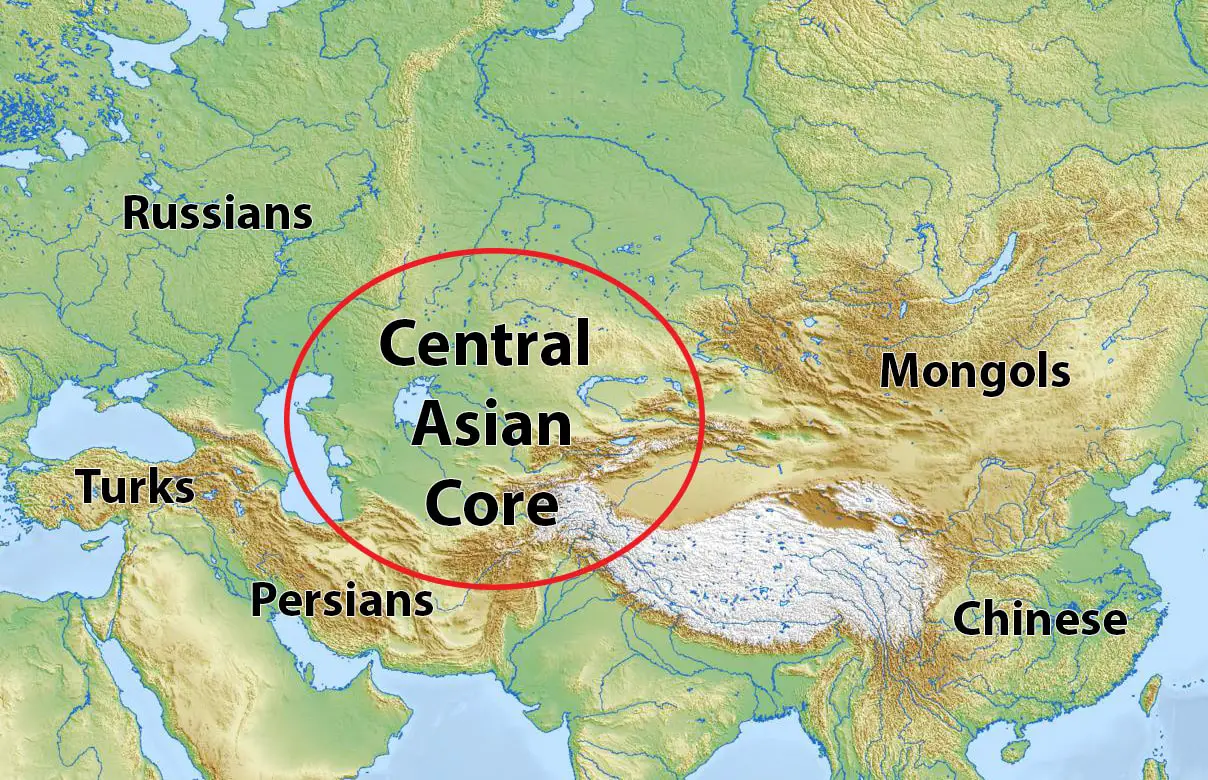
Central Asia: Core and Periphery
Central Asia is, by its most common definition, those five “stans” that were formerly Soviet republics: Kazakhstan, Kyrgyzstan, Tajikistan, Turkmenistan, and Uzbekistan. However, this has…
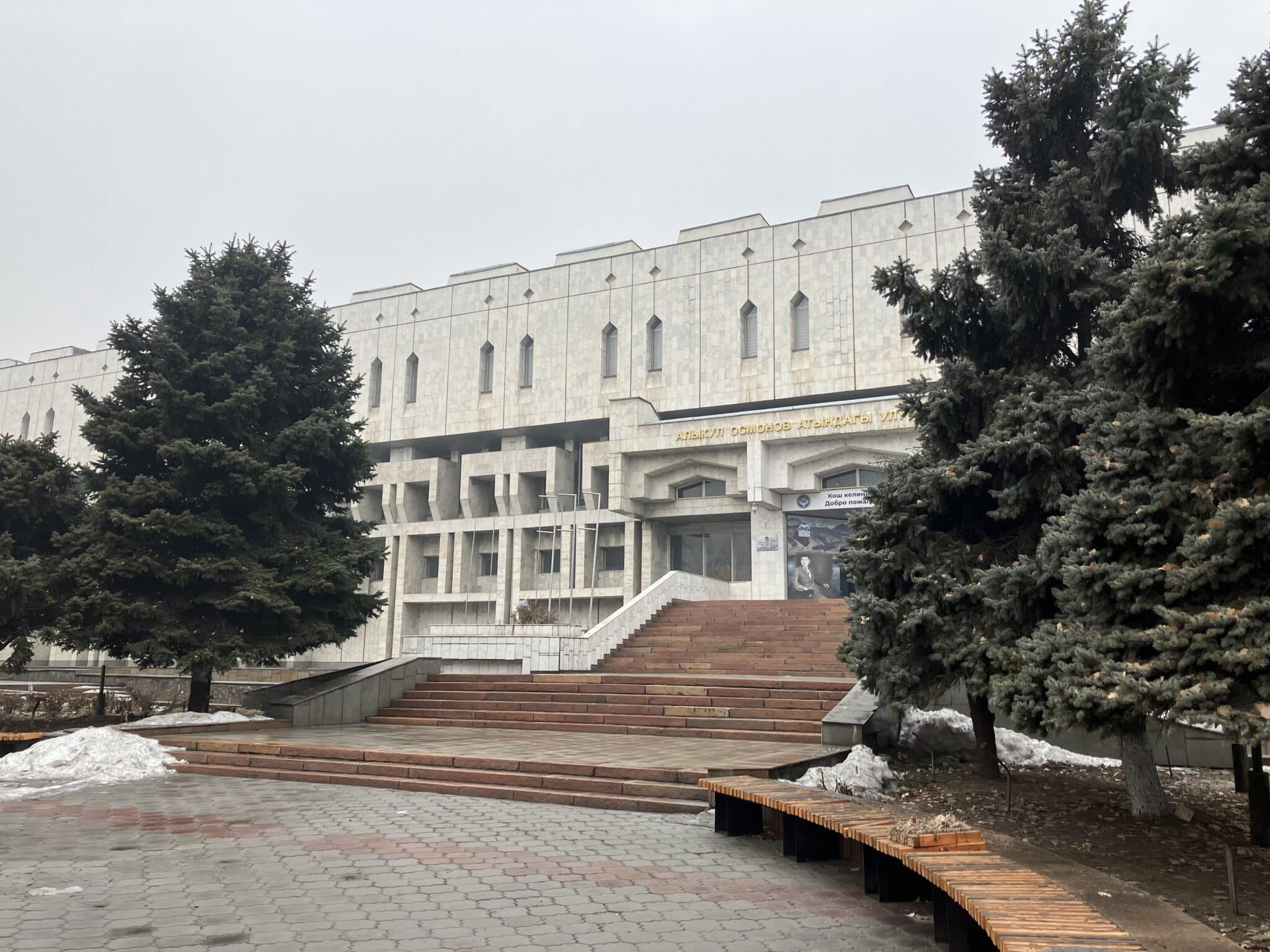
The Alykul Osmonov National Library of Kyrgyzstan
In 1934, the National Library of Kyrgyzstan was formed following the merging of the Frunze City Library and the Library of the Council of People’s…
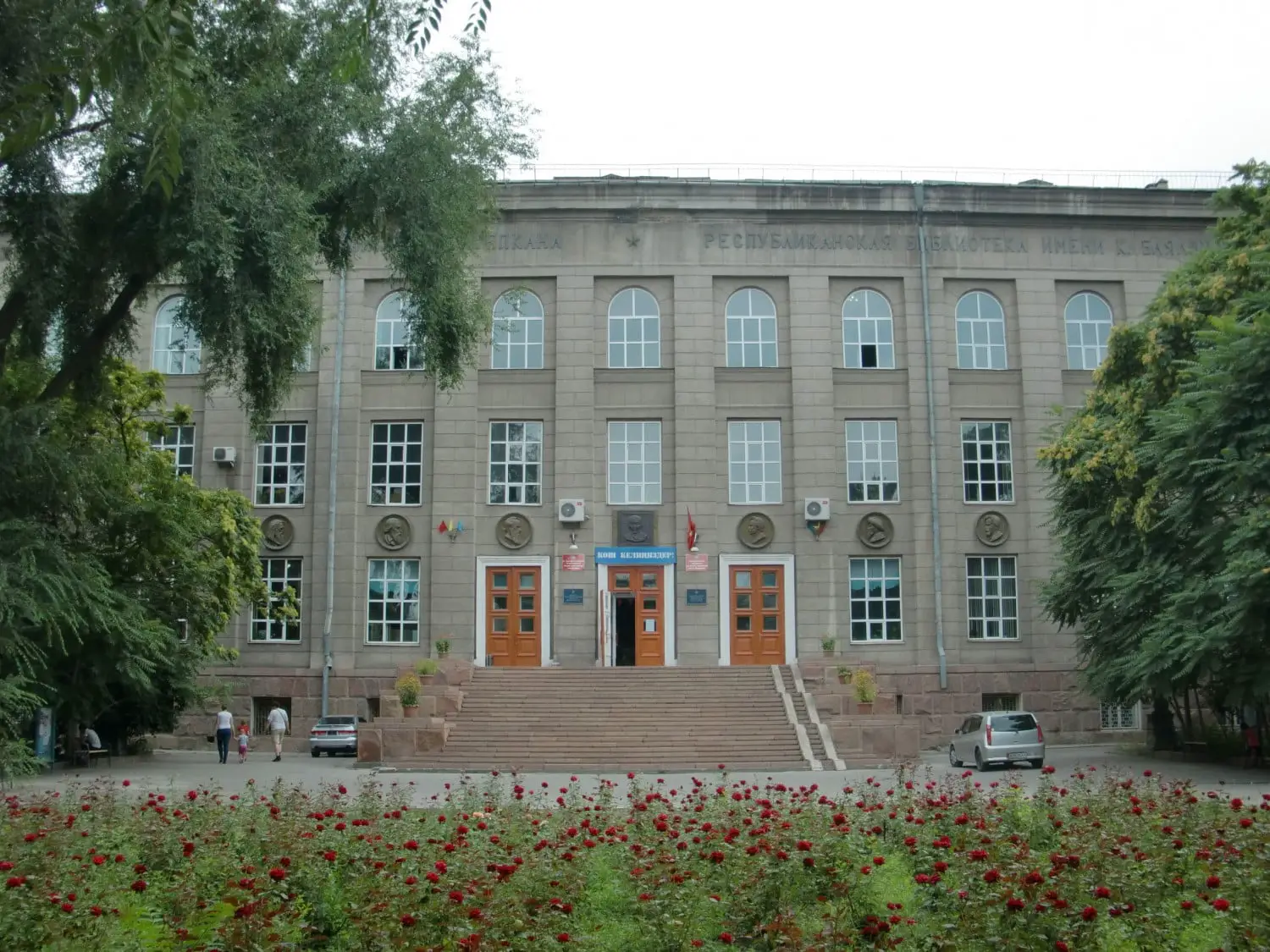
Bayalinov Children’s Library in Bishkek, Kyrgyzstan
The current building housing the K. Bayalinov Library for Children and Youth was built in 1984. It’s located at Ogonbayeva Ataya, 242, near the National…
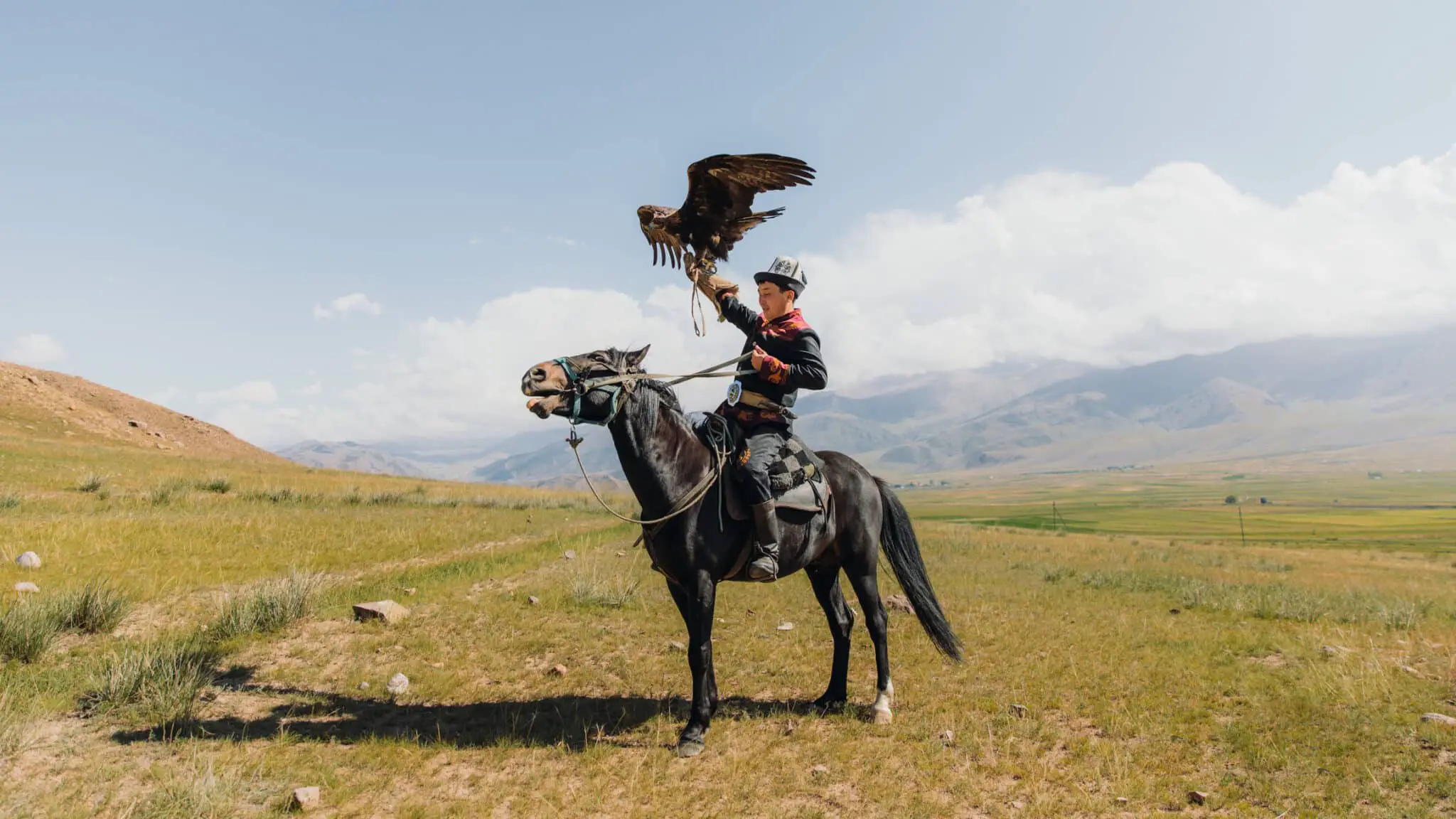
Kyrgyzstan: A GeoHistory Study Guide
Kyrgyzstan is a small, strikingly mountainous country near the center of the immense Eurasian landmass. Influences from diverse empires can be felt there today: Mongol,…



